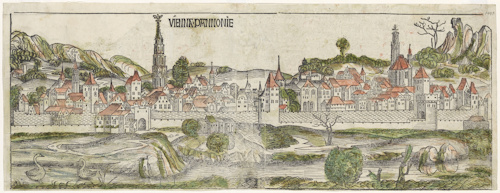
The Habsburg empire is the informal and unofficial term used by many people to refer to the central European monarchy that ruled over a collection of lands from the 13th century to 1918.
- The Habsburg ruler held numerous titles
- The area under their control changed with time
- Core lands in central and eastern Europe
- Not a true empire as such until 1804
- Book a tour* of the Habsburg capital
- See also:
- Previous: Habsburg overview
- Next: The Habsburgs and the Holy Roman Empire
From small beginnings…
Although the Habsburgs trace their roots back into the 10th century and present-day Switzerland, the family really came to prominence in the 1270s.
To cut a long story short…Rudolf I, newly-elected King of Germany and a Habsburg, objected to King Ottokar II of Bohemia’s refusal to accept Rudolf’s authority.

(Rudolf I defeats Ottokar II as pictured by Daniel Nikolaus Chodowiecki in 1783. Image courtesy of the Rijksmuseum)
Like many good monarchs of the day, Rudolf decided to take a practical approach to negotiation and rely on the proven tactic of pointing the sharp end of a sword at Ottokar.
When the (battle) dust settled, our early Habsburg had taken possession of a small Duchy called Austria for his crown, which included a place called Vienna. Aha!
And so began the long story of Vienna and the “Habsburg empire”.
Tip: Rudolf is one of the figures that appear on the famous Ankeruhr clock in Vienna’s old town.
The Habsburg lands
Rudolf’s lands could hardly be considered an empire, unofficially or otherwise. He was a relatively powerful monarch for the time, but not master of much of Europe.

(View of Vienna from the north by Michel Wolgemut in 1493; Wien Museum Inv.-Nr. 31024; excerpt reproduced with permission under the terms of the CC0 licence)
Across the subsequent 650 years, however, the Habsburg family accumulated more and more possessions and titles. The lands making up this “empire” (and the relationships between them) changed continuously thanks to weddings, wars, inheritances, family divisions, political agreements, and so on.
Despite these changes, certain regions featured regularly throughout the period of Habsburg rule:
- What you might call the traditional hereditary lands: much of modern-day Austria and Slovenia, with adjoining bits of Bavaria and Italy thrown in. This core group of dominions included Vienna, of course
- Bohemia, Moravia and Silesia: most of today’s Czechia and southwest Poland
- Hungary: not just today’s Hungary, but also Slovakia, Romania, and northern parts of ex-Yugoslavia

(The Böhmische Hofkanzlei on Judenplatz in today’s Vienna; in centuries past, the building housed the administrative authority for the Bohemian territories)
The exact dimensions of the Hungarian part of these Habsburg lands often depended on the state of relations with the Ottoman empire further out to the east (the Ottomans even laid siege to Vienna twice; once in 1529 and once in 1683).
In summary, this Habsburg “empire” incorporated much of what we think of today as central and eastern Europe.
And Vienna was the de facto capital – the “imperial city” – for almost the entire period of Habsburg hegemony.
Other bits of Europe also drifted in and out of this “empire”. For most of the 18th century, for example, the Habsburgs ruled the Austrian Netherlands, an area covering much of modern Belgium and Luxembourg.

(Map of the Southern (Austrian) Netherlands, Joachim Ottens, 1719. Courtesy of the Rijksmuseum)
And, just to confuse matters, some of the other monarchs in Europe also bore the Habsburg name. A branch of the family ruled Spain, for example, from 1516 to 1700.
An empire, but not in name
Until 1804, however, this collection of central European lands never formed a distinct nation or empire at all. The term “empire” is simply a convenient word to describe all the disparate lands ruled by this particular Vienna-centered branch of the Habsburg family.
You can’t think of these Habsburg lands as a single state run from an administrative center, even though all the various dominions shared a common Habsburg monarch. Each land enjoyed various degrees of autonomy, for example.
For most of history, then, a Habsburg monarch was never King or Queen (or Emperor or Empress) of a conglomerate of Habsburg lands at all. Instead, they held a long list of distinct titles made up of the local titles given to the sovereign in each of the various states throughout their territories.

(Maria Theresa as the Queen of Hungry, after 1741, painted by the artist Martin van Meytens, Wien Museum Inv.-Nr. 61010, reproduced under the terms of the CC BY 4.0 license; photo by Birgit and Peter Kainz)
So a (male) Habsburg monarch might call himself Archduke of Austria, King of Dalmatia, Duke of Lorraine, Grand Prince of Transylvania, Prince of Brixen, Lord of Triest, and…a whole lot more.
Now we have a problem.
Nearly all the past Habsburg monarchs you see mentioned throughout Vienna seem to have the title Emperor or Empress. But we just said there was no formal, unified “Habsburg empire” as such, at least not until the early 19th century (we’ll cover that change later in this series of articles).
No empire means, of course, nobody gets to call themselves emperor or empress.
However, the emperor title back before 1804 came from the fact that the ruling Habsburg was almost always simultaneously the elected head of an actual (and entirely different) empire: the Holy Roman Empire.